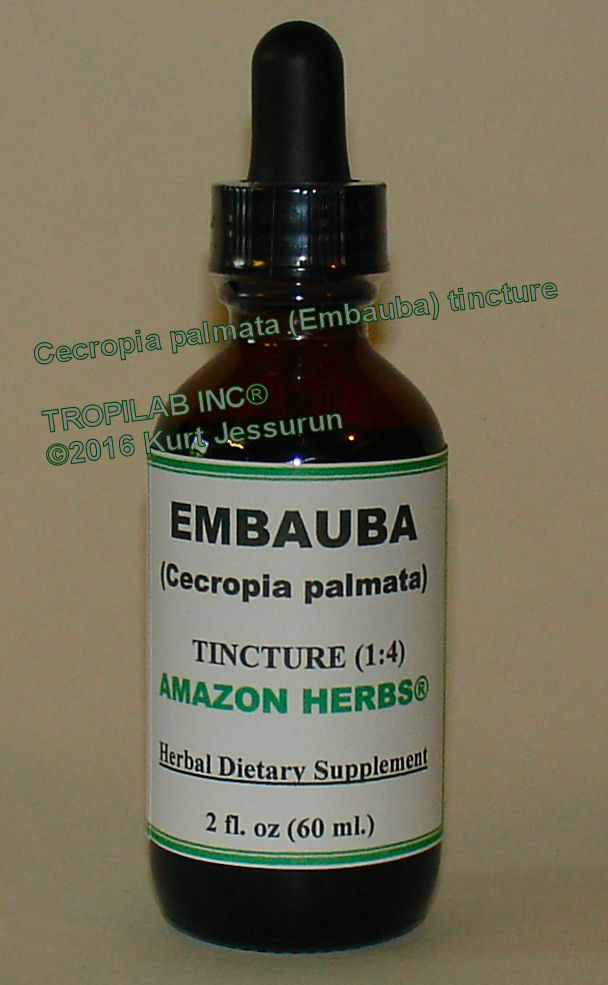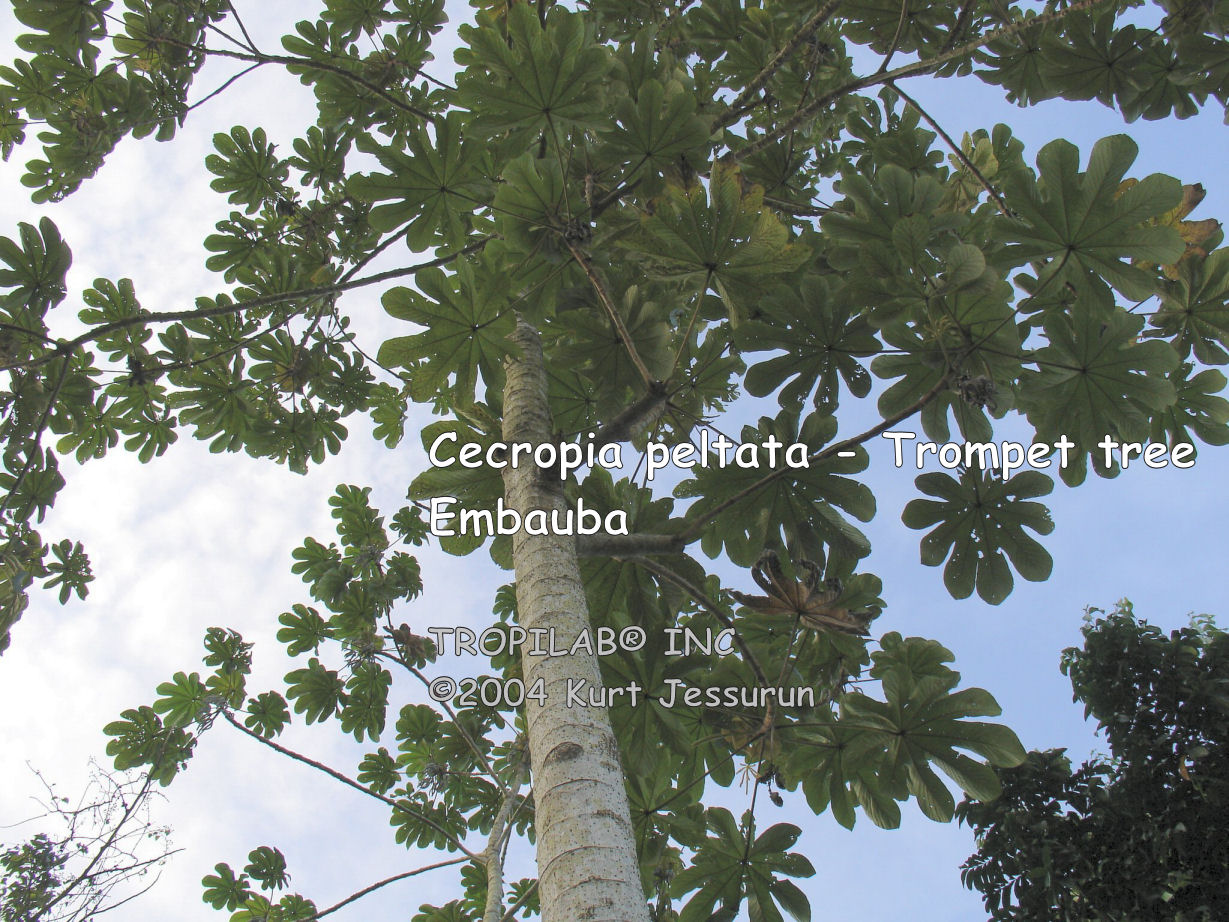 |
 |
|
EMBAUBA TEA (infusio CECROPIA PALMATA) from AMAZON HERBS® |
 Overview
OverviewEmbauba (Cecropia species) also called Trumpet tree, is used against lung problems. Such as the relief of asthma, cough and other upper and lower respiratory complaints (bacterial- and viral infections). These are bronchitis, Chronic Obstructive Pulmonary Disease (COPD), emphysema, pulmonary sarcoidosis as well diabetes. It is also used for sores on the mouth and/or tongue. It is excellent for weight control and adequate against hypertension. The herbal tincture and tea can be considered as a very adequate herbal support for the lungs and respiration system. Embauba has strong anti-inflammatory properties. Constituents Glycosides, lipids, alkaloids, flavonoids, tannins, cardenolids, triterpenes, polyphenols, steroids, ursolic acid, resins and proanthocyanidines. Pharmacology  In the plasma, Embauba can produce hypotension (by central blockage of the sympathic
innervation of vessels) and tachycardia (by central cholinergic inhibition of the heart).
In the plasma, Embauba can produce hypotension (by central blockage of the sympathic
innervation of vessels) and tachycardia (by central cholinergic inhibition of the heart).Vascular relaxation induced by a methanol extract and the flavonoid fraction could explain the traditional use in South America of the herbal extract of Cecropia species as a remedy for arterial hypertension. The flavonoids and proanthocyanidins in Embauba were reported to inhibit Angiotensin-Converting Enzyme (ACE). [ACE-inhibitors are a class of drugs used for hypertension which promote vasodilation]. The traditional use of this plant for high blood pressure can be explained by the inhibition of ACE in humans and animals. The hypoglycemic effects of extracts, prepared from leaves of Cecropia, were examined. The flavone, isoorientin and 3-caffeoylquinic acid (chlorogenic acid), were isolated as the important constituents of the plant and were identified as the main constituents in the extracts. The extracts showed similar hypoglycemic effect as the drug Glibenclamide (glyburide). Cecropia obtusifolia has been widely used in Mexican Traditional Medicine for the control of type 2 diabetes. An infusion (herbal tea) prepared with the leaves of C. obtusifolia produced beneficial effects on carbohydrate and lipid metabolisms when it was administered as an adjunct on patients with type 2 diabetes with poor response to conventional medical treatment. Results suggest that C. peltata is a better hypoglycemic agent than C. obtusifolia, and it could be considered for developing a phytomedicinal product to carry out clinical trials. The administration of Embauba can improve glycemic control by blocking the hepatic glucose output, especially in the fasting state. These data support the traditional use of the plants as a cold infusion of the plant consumed over the course of a day. In tropical South America there is popular use of Cecropia obtusifolia (an Embauba species) in rheumatic and kidney inflammation due to its topical and systemic anti-inflammatory effect. Substances found in the bark included tannins in small amounts, ursolic acid, flavonoids and considerable quantities of steroids. The bark is also used medicinally. Dosage Tincture: 1 - 3 ml daily Infusion (herbal tea): 1 - 2 cups daily Many customers use Embauba together with Acerola for Strong Immune Support. Interactions May potentiate cardiotonics as well as anti-hypertensive and ACE-inhibitor drugs. It may also potentiate anti-diabetic and insulin drugs. Since Embauba is traditionally used for aiding childbirth and to promote menstruation, it should NOT be taken during pregnancy. Reference Antigonorrhoeal activity of plants used in Guatemala for the treatment of sexually transmitted diseases. A. Caceres, H. Menendez, E. Mendez, E. Cohobon, B.E. Samayoa, E. Jauregui, E. Peralta, G. Carrillo. J Ethnopharmacology, 1995; 48: 85-88. Biological screening of selected medicinal Panamanian plants by radioligand-binding techniques. Caballero-George C, Vanderheyden PM, Solis PN, Pieters L, Shahat AA, Gupta MP, Vauquelin G, Vlietinck AJ. Department of Pharmaceutical Sciences, University of Antwerp, Belgium. ccaballe@uia.ua.ac.be The Ethnobotany Database. http://probe.nalusda.gov:8300/cgi-bin/browse/ethnobotdb (ACEDB version 4.3 -data version July 1994). Beckstrom-Sternberg, Stephen M., James A. Duke, and K.K. Wain. Gluconeogenesis inhibition and phytochemical composition of two Cecropia species. Andrade-Cetto A, Vázquez RC. Laboratorio de Etnofarmacología, Facultad de Ciencias, Universidad Nacional Autónoma de México, Apartado Postal 70-359, Coyoacan, 04511 México DF, Mexico. aac@fciencias.unam.mx Manual de Dendrologia de Algunas Especies de Honduras. Programa Forestal ACDI-COHDEFOR, 1981. Paquet, J. The Phytochemical Database. http://probe.nalusda.gov:8300/cgi-bin/browse/phytochemdb. (ACEDB version 4.3 - data version July 1994). Beckstrom-Sternberg, Stephen M., and James A. Duke. A phytochemical study of the bark tissues of Cecropia peltata. Prista, L.N.; Alves, A.C. Estudo fitoquímico de cascas de Cecropia peltata L. The above presentation is for informational and educational purposes only. It is based on scientific studies (human, animal, or in vitro), clinical experience, or traditional usage. For many of the conditions discussed, treatment with prescribed (RX) or over - the - counter medication (OTC) is also available. Consult your doctor, practitioner, and/or pharmacist for any health problem and before using dietary supplements or before making any changes in prescribed medications. |
|
For the right freight rate, shipping charges, conditions and delivery service, please visit our Webstore page! |
|
TROPILAB® INC |